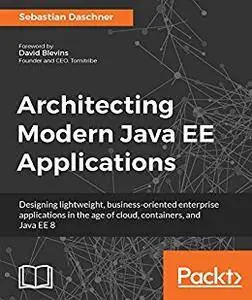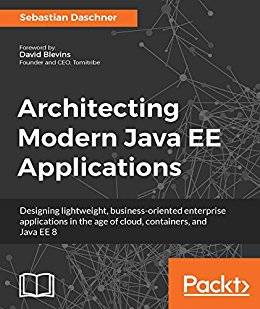Architecting Modern Java EE Applications: Designing lightweight, business-oriented enterprise applications in the age of cloud, containers, and Java EE 8 by Sebastian Daschner
English | 9 Oct. 2017 | ISBN: 1788393856 | ASIN: B0761YQNRM | 442 Pages | AZW3 | 1.35 MB
English | 9 Oct. 2017 | ISBN: 1788393856 | ASIN: B0761YQNRM | 442 Pages | AZW3 | 1.35 MB
Find out how to craft effective, business-oriented Java EE 8 applications that target customer's demands in the age of Cloud platforms and container technology.
About This Book
Understand the principles of modern Java EE and how to realize effective architectures
Gain knowledge of how to design enterprise software in the age of automation, Continuous Delivery and Cloud platforms
Learn about the reasoning and motivations behind state-of-the-art enterprise Java technology, that focuses on business
Who This Book Is For
This book is for experienced Java EE developers who are aspiring to become the architects of enterprise-grade applications, or software architects who would like to leverage Java EE to create effective blueprints of applications.
What You Will Learn
What enterprise software engineers should focus on
Implement applications, packages, and components in a modern way
Design and structure application architectures
Discover how to realize technical and cross-cutting aspects
Get to grips with containers and container orchestration technology
Realize zero-dependency, 12-factor, and Cloud-native applications
Implement automated, fast, reliable, and maintainable software tests
Discover distributed system architectures and their requirements
In Detail
Java EE 8 brings with it a load of features, mainly targeting newer architectures such as microservices, modernized security APIs, and cloud deployments. This book will teach you to design and develop modern, business-oriented applications using Java EE 8. It shows how to structure systems and applications, and how design patterns and Domain Driven Design aspects are realized in the age of Java EE 8. You will learn about the concepts and principles behind Java EE applications, and how to effect communication, persistence, technical and cross-cutting concerns, and asynchronous behavior.
This book covers Continuous Delivery, DevOps, infrastructure-as-code, containers, container orchestration technologies, such as Docker and Kubernetes, and why and especially how Java EE fits into this world. It also covers the requirements behind containerized, zero-dependency applications and how modern Java EE application servers support these approaches. You will also learn about automated, fast, and reliable software tests, in different test levels, scopes, and test technologies. This book covers the prerequisites and challenges of distributed systems that lead to microservice, shared-nothing architectures. The challenges and solutions of consistency versus scalability will further lead us to event sourcing, event-driven architectures, and the CQRS principle. This book also includes the nuts and bolts of application performance as well as how to realize resilience, logging, monitoring and tracing in a modern enterprise world. Last but not least the demands of securing enterprise systems are covered.
By the end, you will understand the ins and outs of Java EE so that you can make critical design decisions that not only live up to, but also surpass your clients' expectations.
Style and approach
This book focuses on solving business problems and meeting customer demands in the enterprise world. It covers how to create enterprise applications with reasonable technology choices, free of cargo-cult and over-engineering. The aspects shown in this book not only demonstrate how to realize a certain solution, but also explain its motivations and reasoning.



